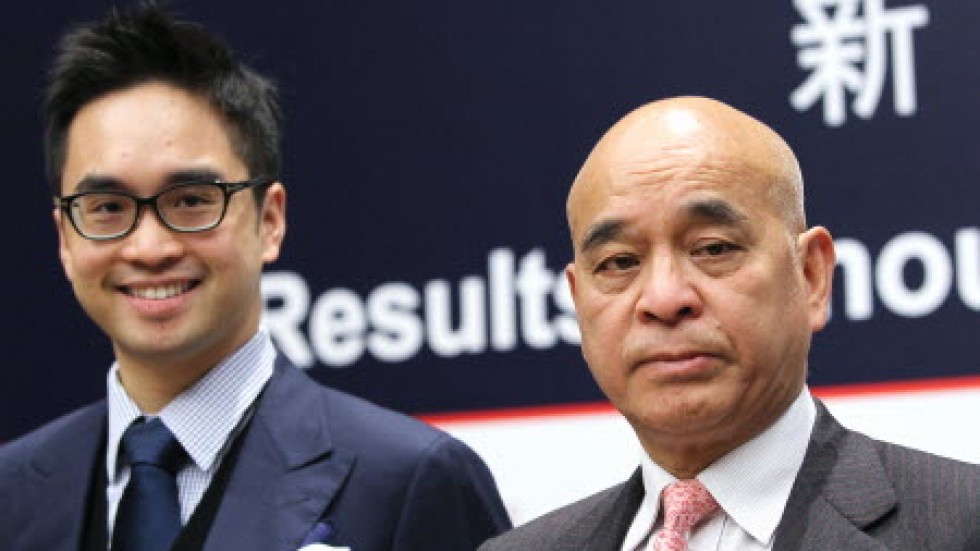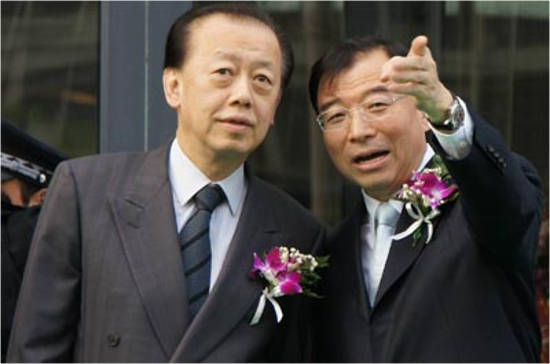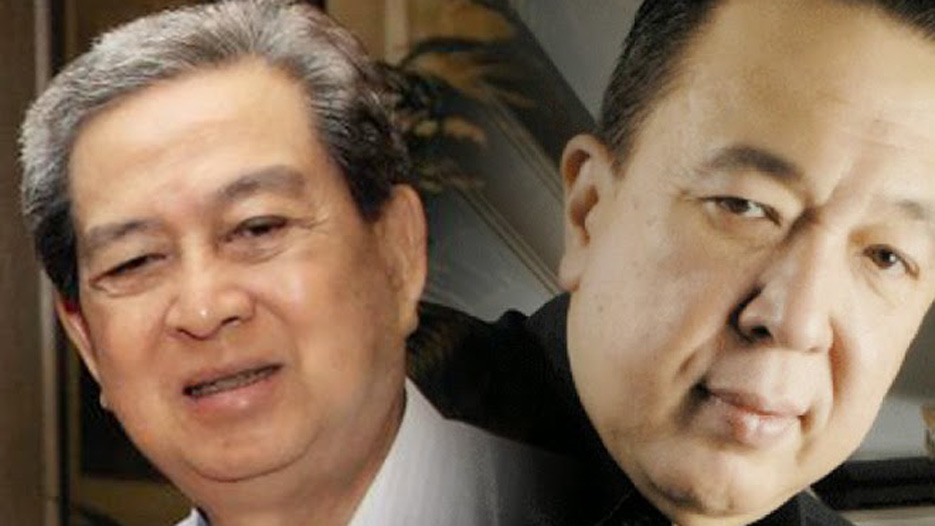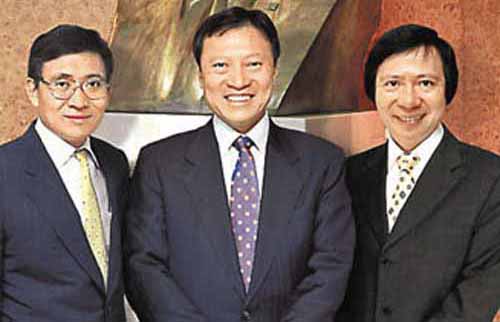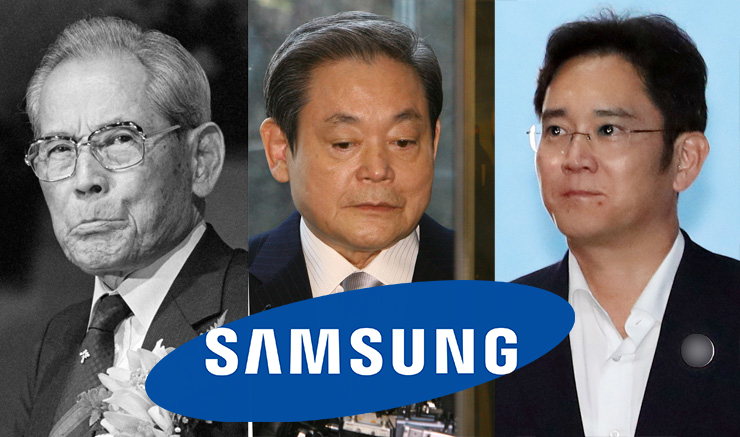10. Keluarga Chirathivat (Thailand)

Anggaran Nilai Kekayaan: US$19.3 bilion
Klan peruncit ini merupakan pemilik kepada pemaju pusat beli
belah iaitu Central Group, yang memperolehi 30% daripada US$9.6 bilion
pendapatannya dari luar negara.
Pada tahun 1927, Tiang Chirathivat yang merupakan immigran
dari China membuka kedai runcit pertama beliau di Bangkok. Kedai tersebut
diberi nama Keng Seng Lee.
Pada tahun 1956, anak Tiang iaitu Samrit membuka sebuah
department store pertama negara tersebut, di kawasan kejiranan Wang Burapha di
Bangkok.
Kini diterajui oleh cucu Tiang, syarikat berkenaan memiliki
perniagaan fesyen Zalora. Mereka mempunyai kerjasama dengan JD.com sebuah,
syarikat China dengan pelaburan bersama sebanyak US$500.
9. Keluarga Sy (Filipina) - SM Investments Corporation
Anggaran Nilai Kekayaan: US$20.1 bilion
Henry Sy merupakan individu paling kaya di Filipina. Beliau
bermula dengan perniagaan kedai kasut di Manila dan kemudiannya sebagai pemaju
hartanah melalui SM Prime.
SM Inverstment Corp. milik keluarga ini kini merupakan
peruncit terbesar di Filipina, mempunyai lebih 200 outlet kedai. 6 daripada
anak-anak beliau terlibat dengan pengurusan syarikat, dengan penglibatan aktif
bersama cucu-cucu beliau.
Cucu lelaki beliau iaitu Howard baru-baru ini memulakan
perusahaan beliau sendiri iaitu StorageMart, sebuah syarikat penyimpanan barang
di Makati, Filipina.
8. Keluarga Cheng (Hong Kong) - Chow Tai Fook
Anggaran Nilai Kekayaan: US$22.5 bilion
Pengasas keluarga ini baru sahaja meninggal dunia pada
September 2016. 4 tahun sebelumnya, beliau melantik anak sulung beliau, Henry
sebagai pengerusi dan pengarah eksekutif syarikat emas keluarga iaitu Chow Tai
Fook dan konglomerat New World.
Anak perempuan Henry, Sonia menyelia bidang perhotelan dan
telah membeli syarikat bertaraf bintang Rosewood Hotels pada tahun 2011.
Anak lelaki beliau, Adrian menguruskan New World dan
menubuhkan C Ventures, sebuah syarikat pelaburan yang mempunyai fokus terhadap
pasaran fesyen China.
7. Keluarga Kwek / Quek (Malaysia) - Hong Leong Group
Anggaran Nilai Kekayaan: US$23.3 bilion
Lebih daripada 15 orang ahli keluarga ini menguasai Hong
Leong Group, sebuah konglomerat dengan penglibatan dalam kewangan hinggalah ke
bidang hartanah.
Sejarah keluarga ini berbalik kepada tahun 1941, apabila Kwek
Hong Png mengasaskan sebuah syarikat bersama 3 orang adik beradik beliau.
Anak sulung beliau, Kwek Leng Beng kini mengendali operasi di
Singapura. Cucu lelaki beliau iaitu Sherman akan mengambil alih syarikat
keluarga City Developments pada Januari 2018 sebagai Ketua Eksekutif.
Sepupu beliau iaitu Quek Leng Chan kini mengendalikan urusan
Group tersebut di Malaysia.
6. Keluarga Lee (Shau Kee) (Hong Kong) - Henderson Development
Anggaran Nilai Kekayaan: US$29 bilion
Shau Kee berpindah ke Hong Kong dari Guangdong, China pada
tahun 1948 dan memulakan perdagangan logam berharga dan pertukaran mata wang.
Beliau merupakan pengasas bersama syarikat hartanah Sun Hung Kai bersama 2
orang rakan kongsi.
Namun kerana tidak sehaluan, beliau meninggalkan syarikat
tersebut dan mengasaskan sebuah syarikat hartanah iaitu Henderson Development
pada tahun 1973. Beliau kini merupakan pengerusi syarikat
berkenaan.
Anak lelaki beliau, Peter kini mengendalikan operasi di
China, manakal anak perempuan, Margaret adalah seorang eksekutif di syarikat
tersebut.
5. Keluarga R. Budi & Michael Hartono (Indonesia)
Anggaran Nilai Kekayaan: US$32 bilion
Selepas keluarga kaya raya iaitu keluarga Salim hilang
penguasaan terhadap Bank Central Asia (BCA) ketika krisis ekonomi Asia 1997-1998,
keluarga Hartono mengambil peluang ini dengan melabur ke BCA.
Keluarga Hartono memperolehi 2/3 daripada pendapatan mereka
melalui pelaburan di BCA.
Sumber pendapatan awal keluarga ini adalah melalui sebuah
syarikat pengeluar rokok, Djarum yang ditubuhkan oleh bapa adik beradik
Hartono. Kini Djarum dikendalikan oleh Victor, anak kepada Budi Hartono.
Antara aset keluarga ini termasuklah jenama elektronik Polytron
dan hartanah di Jakarta.
4. Keluarga Chearavanont (Thailand) - Charoen Pokphand (CP) Group
Anggaran Nilai Kekayaan: US$36.6 bilion
Perniagaan keluarga ini berbalik kepada tahun 1921, apabila
adik beradik Chia ek Chor dan Choncharoen Chiaravanont membuka sebuah kedai
menjual biji benih yang diimport daripada China, untuk dibekalkan kepada petani
di Thailand.
Kini, Group syarikat berkenaan dikendalikan oleh anak Chia,
iaitu Dhanin. Dhanin memainkan peranan sebagai pengerusi dan berkongsi
pendapatan bersama 3 orang adik beradik dan saudara beliau.
Pada Januari 2017, selepas 48 tahun berkhidmat sebagai
pengerusi dan CEO, Dhanin melepaskan jawatan tersebut kepada anak beliau,
Soopakij sebagai pengerusi. Cucu beliau, Suphachai memainkan peranan sebagai CEO
baharu.
3. Keluarga Kwok (Hong Kong) - Sun Hung Kai & Co
Anggaran Nilai Kekayaan: US$40.4 bilion
Kwok Tak-Seng mengasaskan Sun Hung Kai & Co. bersama Fung
King Hey dan Lee Shau Kee pada tahun 1969. 3 tahun kemudian, beliau menubuhkan
Sung Hung Kai Property secara persendirian.
Pada Jun 2017, syarikat ini berjaya berjaya mencapai rekod
penjualan di bawah kontrak sebanyak US$6.7 bilion, Ini merupakan peningkatan
sebanyak 28% daripada pendapatan daripada 12 bulan sebelumnya.
Syarikat ini kini telah berkembang ke China, dengan 60%
daripada 120 juta kaki persegi hartanahnya terletak di negara
tersebut.
2. Keluarga Lee (Byung-Chul) (Korea Selatan) - Samsung Electronics
Anggaran Nilai Kekayaan: US$40.8 bilion
Pada tahun 1938, mendiang Lee Byung-Chul memulakan syarikat
beliau sebagai sebuah kedai runcit yang menjual pelbagai barangan harian
termasuklah ikan kering. Perniagaan beliau telah berubah menjadi kepada sebuah
empayar, dan kini menjadi pengeluar telefon pintar dunia beserta barangan
elektronik yang lain.
Pada era 1990an, konglomerat ini berpecah kepada 4 entiti
bebas, iaitu Samsung, CJ, Shingsegae dan Hansol. Kesemua perniagaan ini kini
dikendalikan oleh generasi kedua dan ketiga keluarga Lee.
Empayar perniagaan Samsung kini menghasilkan pendapatan lebih
daripada US$300 bilion jualan tahunan daripada barangan elektronik, peruncitan,
makanan, hiburan dan lain-lain.
Untuk mengetahui lebih lanjut tentang syarikat Samsung.
1. Keluarga Ambani (India) - Reliance Group
Anggaran Nilai Kekayaan: US$44.8 bilion
Dhirubhai Ambani merupakan pengasas kepada keluarga ini.
Sebelum mengasaskan syarikat Reliance Textile Industries, beliau pernah bekerja
di stesen minyak di Yaman. Beliau juga pernah memiliki perniagaan rempah ratus
sebelumnya.
Reliance Textile Industries menjadi jenama tekstil terkenal
di India setelah ia dilancarkan. Selepas kematian Dhirubhai pada tahun 2002,
anak mendiang, Mukesh dan Anil mengambil alih group syarikat berkenaan dan
dikatakan tidak serasi.
Empayar perniagaan tersebut kemudiannya berpecah, dan
Reliance Group terus diterajui oleh Mukesh. Selain industri tekstil, syarikat
ini turut menceburi beberapa bidang perniagaan lain seperti telekom, minyak,
dan lain-lain.
Sambungan Senarai Keluarga Paling Kaya di Asia
11. Keluarga Premji - US$19.2 bilion / India / Wipro
12. Keluarga Hinduja - US$18.8 bilion / UK
13. Keluarga Tsai (Wan-Tsai) - US$17.7 / Taiwan /
Cathay Financial
14. Keluarga Mittal - US$17.2 / India / ArcelorMittal
15. Keluarga Kuok - US$16.6 bilion / Malaysia / Kuok Group
16. Keluarga Mistry - US$16.1 bilion / India / Shapoorji
Pallonji Group
17. Keluarga Chung - US$14.8 bilion / Korea Selatan / Hyundai
18. Keluarga Saji - US$14.2 bilion / Jepun / Suntory
19. Keluarga Birla - US$14.1 bilion / India
20. Keluarga Godrej - US$14 bilion / India / Godrej Group
21. Keluarga Pao - US$13.4 bilion / Hong Kong / BW Group
22. Keluarga Yoovidhya - US$13.1 bilion / Thailand
23. Keluarga Kadoorie - US$11 bilion / Hong Kong / CLP
Holdings Ltd.
24. Keluarga Widjaja - US$10.4 bilion / Indonesia / Sin Armas
Group
25. Keluarga Ng - US$9.7 bilion / Singapura / Far East
Organization
26. Keluarga Bajaj - US$9.3 bilion / India / Bajaj Group
27. Keluarga Salim - US$8.8 bilion / Indonesia / Salim Group
28. Keluarga Koo - US$8.7 bilion / Korea Selatan / LG Corp.
29. Keluarga Lohia - US$8.68 bilion / Indonesia / Indorama
Corporation
30. Keluarga Lee Man Tat - US$8.4 bilion / Hong Kong
Sumber : Iluminasi.com
Forex Trading Scams to Watch
The
forex market involves very active trading of over $1 trillion each day, not
including futures and currency options, which put the trading at closer to $5
trillion daily. The market does not have
much in the way of regulation, although things have started to improve
recently.
The
opportunity still exists for many forex scams, which tempt new investors with a
promise of quick fortunes through "secret trading formulas" or
algorithm-based "proprietary" trading methodologies. Before choosing
a broker or platform, go through your own due diligence by visiting BASIC, or
the Background Affiliation Status Information Center, created by the
self-regulatory NFA (National Futures Association).
01
Signal Sellers
Stock
Market Illustration
One
of the challenges a rookie forex investor faces is determining which operators
to trust in the forex market and which to avoid. Signal sellers make a good
example.
Basically,
a signal seller is offering a system that purports to identify favorable times
for buying or selling a currency pair. The system may be manual, where the
trader enters the info and gets a result, or it may be automated.
Some
systems rely on technical analysis, others rely on breaking news and many
employ some combination of the two. But they all purport to provide information
that leads to favorable trading opportunities. Signal sellers usually charge a
daily, weekly or monthly fee for their services.
Some
analysts propose that many or even most signal sellers are scam artists. A
frequent criticism is that if it were really possible to use a system to beat
the market, why would the individual or firm that has this information make it
widely available? Wouldn't it make more sense to use this incredible signaling
system to make huge profits?
Other
analysts distinguish between known scammers and more reputable information
sources such as Metatrader, that offer a well-thought-out signaling service.
Behind
these opposing views lies a larger difference of opinion about whether anyone
can predict the next move in a trading market. This fundamental disagreement
won't be settled any time soon. Nobel Prize-winning Economist Eugene Fama
proposes in his well-regarded Efficient Market Hypothesis that finding these
kinds of momentary market advantages really isn't possible.
His
economist colleague, Robert Shiller, also a Nobel Prize winner, believes
differently, citing evidence that investor sentiment creates booms and busts
that can provide investment and trading opportunities.
The
best way to determine if a signal seller can benefit you is to open a paper
money or practice trading account with one of the better-known forex brokers.
Be patient, and eventually, you'll determine whether predictive signaling works
for you or doesn't.
02
Phony Forex Investment Management Funds
In
the world of investing, outrageous claims are the surest sign of potential
fraud
In
the past few years, forex management funds have proliferated. Most of these, if
not all, are scams. They offer an investor the "opportunity" to have
his forex trades managed by highly-skilled forex traders who can offer
outstanding market returns in return for a share of the profits.
The
problem is, this "management" offer requires the investor to give up
control over his money and to hand it to someone he knows little about other
than the hyped-up and often completely false record of success available on the
scammer's website and brochures.
The
investor often ends up getting nothing, while the scammer uses investors' funds
to buy yachts and private islands.
A
good rule of thumb in the forex market, as with other investments, is that if
it sounds almost too good to be true, such as annual returns of more than 100
percent, for example, it's almost certainly a scam.
03
Dishonest Brokers
Trader
watching stocks crash on screen
Although the forex market is not entirely
unregulated, it has no central regulating authority. The forex spot market is
completely unregulated and accounts for the majority of trades. Unsurprisingly,
some forex brokers do not deal fairly with their customers and, in some
instances, defraud them.
You
have two ways to avoid bad brokers. Before engaging a forex broker, look the
brokerage up on a website that identifies dishonest forex brokers. Better yet,
trade with a broker that also handles other stock market trades and is subject
to SEC and FINRA oversight. While the forex trade itself may be unregulated, no
broker subject to such oversight would risk its license for other securities by
defrauding its forex customers.


